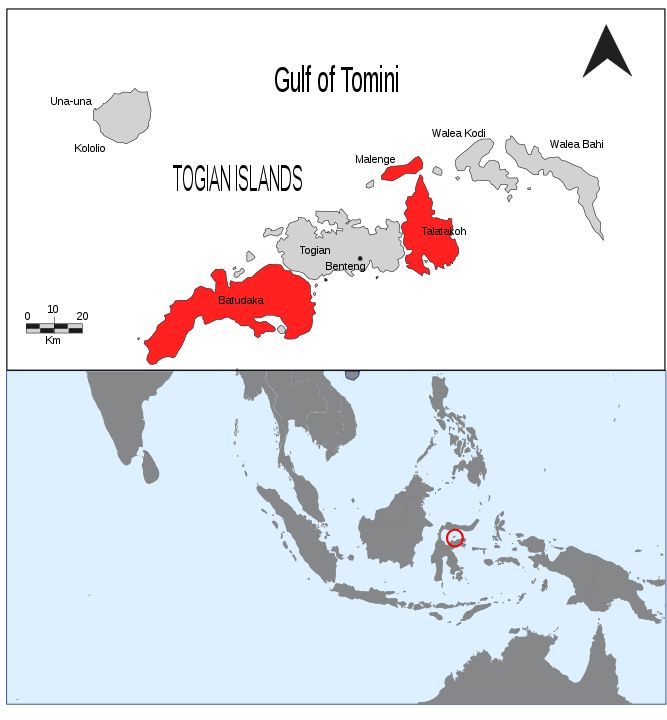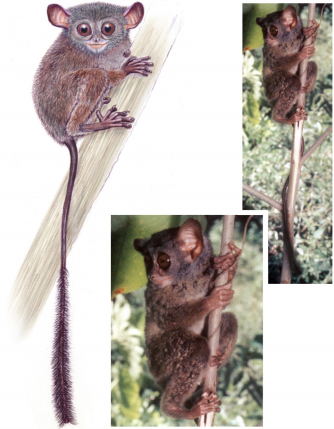- Scientists first spotted a previously unknown type of tarsier on the Togean Islands off Sulawesi, Indonesia, in 1993, and it’s taken 25 years of further studies to describe the diminutive primate species as new to science.
- Niemitz’s tarsier (Tarsius niemitzi) is named after Carsten Niemitz, one of the scientists on that initial visit to the Togean islands, whom the authors of the new paper call “the father of tarsier field biology.”
- There are now 12 known tarsier species found in Sulawesi and surrounding islands, but the paper’s authors say the region could be home to at least 16, with more research needed.
- They warn that loss of habitat makes it “quite plausible” that some tarsier species may go extinct before scientists have a chance to identify them.
JAKARTA — In 1993, scientists Alexandra Nietsch and Carsten Niemitz reported finding tarsiers, a type of small primate, on an island chain off eastern Indonesia’s larger Sulawesi Island.
Sulawesi’s biodiversity was little known then, and the notion that the tarsier from the Togean Islands might be a new species spurred a series of studies that looked at everything from the tarsier’s vocalizations to its DNA sequence.
Finally, in a study published this year in the annual journal Primate Conservation, that initial discovery by Nietsch and Niemitz a quarter of a century ago has been officially confirmed as a new species: Niemitz’s tarsier (Tarsius niemitzi), named in honor of the man “universally regarded as the father of tarsier field biology,” the study says.

“The biodiversity of Sulawesi is much like the biodiversity of the Galapagos Islands, made famous by Darwin’s work,” Myron Shekelle, a professor of anthropology at Western Washington University in Bellingham, WA, and the lead author of the paper describing the new species, told Mongabay in an email.
“Numerous related species were each individually adapted to the specifics of a given island,” he added. “Why would any of us choose to walk away, while species remain undescribed and questions remain unanswered?”
Shekelle was also the lead author of a 2017 report describing two new tarsier species from the northern peninsula of Sulawesi.

While newly described to science, T. niemitzi has long been known to locals by the names bunsing, tangkasi and podi. Its weight and tail length fall within the range of a number of other tarsier species, but the tarsier from the Togean Islands lacks a reduced tail tuft, which is atypical for tarsiers endemic to small islands, according to the study.
Vocalization analysis based on recordings show that its duet is structurally simple, possibly the simplest of all known tarsier duets, the paper adds. “Togean tarsiers are unique among known tarsier acoustic forms in that they respond in playback experiments to all other tarsier duet calls by duetting themselves,” the authors write.
They also looked into the conservation status of the Niemitz’s tarsier and suggested it be classified as endangered, largely due to its isolation on the Togean Islands, cut off from the Sulawesi main island by water that goes down to depths greater than 120 meters (400 feet).
“The broader implication is that the Togean Islands possess a largely endemic biota of taxa that do not disperse easily across water barriers,” the paper says.
These nocturnal creatures can easily leap 3 meters (10 feet) or more in a single bound, thanks to their super-elongated legs — the longest legs relative to arm length of any primate species. Tarsiers, which are found only on a handful of islands in Southeast Asia, use their extraordinary jumping ability to target prey with laser-like precision. They’re the only purely carnivorous primates on Earth, with a diet consisting largely of insects and lizards.
To spot their next meal in the darkness of night, tarsiers have developed the largest eyes relative to body size of any known mammal, a crucial adaptation that grants them better night vision even in the absence of the reflective eyeball tissue that most nocturnal species have (think of the spooky glow of raccoon or cat eyes). Tarsiers’ eyes are so large, in fact, that the creatures can’t even swivel them in their sockets — a limitation they’ve adapted to by developing the ability to swivel their heads 180 degrees in either direction, like an owl.

The description of T. niemitzi brings to 12 the number of known tarsier species found in Sulawesi and surrounding islands. But Shekelle and his co-authors say Sulawesi could be home to at least 16 species of tarsiers, adding that further investigation of other species is needed.
“The ability to answer many of the most interesting questions is slipping from our grasp, while at the same time it is quite plausible that some tarsier species may go extinct before we have even identified them,” Shekelle said.
Funding for wildlife conservation efforts in general, and for tarsiers in particular, is inadequate to make them fully effective or stabilize the loss of the species’ habitat and the loss of biodiversity within their habitat, Shekelle said.
“Nevertheless, while the conservation picture is gloomy, we are also aware that the tarsiers of Sulawesi serve as powerful conservation mascots for tourism, flagship species for awareness, and umbrella species to help protect all of the other Sulawesian biota, both known and unknown,” he said.
Citation:
Shekelle, M., Groves, C. P., Maryanto, I., Mittermeier, R. A., Salim, A., & Springer, M. S. (2019). A new tarsier species from the Togean Islands of Central Sulawesi, Indonesia, with references to Wallacea and conservation on Sulawesi. Primate Conservation, 33.
FEEDBACK: Use this form to send a message to the author of this post. If you want to post a public comment, you can do that at the bottom of the page.
